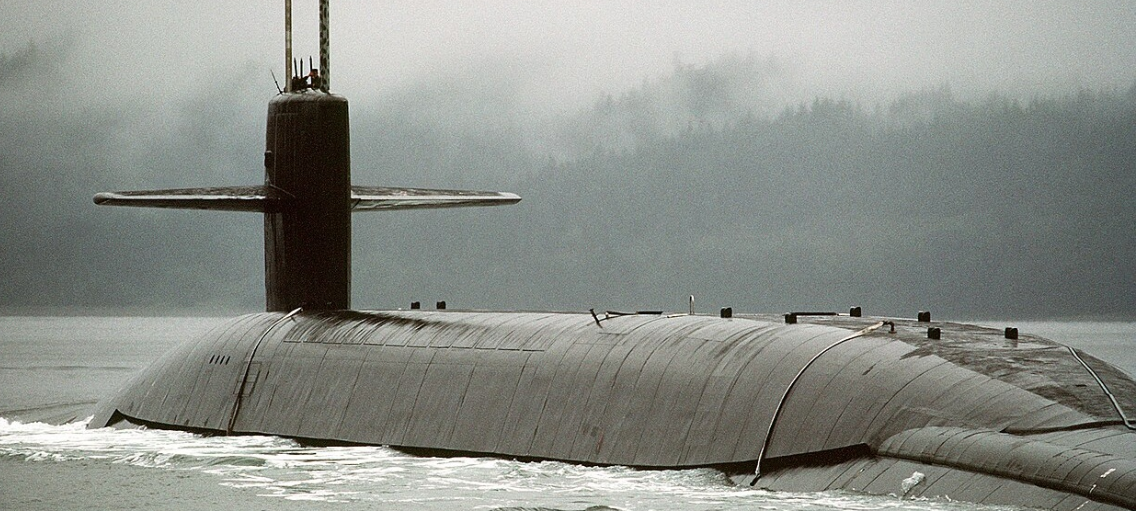Can the submarine USS Ohio Really Deter China on Its Own?

Sure, the presence of the Ohio will serve as a check to any twitchy Chinese force—for now. But the balance of military power in the Indo-Pacific is shifting away from the United States.
There is a crisis brewing in the United States Navy. It lacks adequate numbers of warships and submarines to dominate the High Seas, as the branch’s doctrine demands.

Multiple successive presidential administrations have waxed eloquent about the need to expand the size of America’s navy—especially in light of the China challenge. Yet little movement has been made on this herculean task. To compound matters, the Navy is overcommitted to its nuclear-powered aircraft carriers, and there simply are not enough of those to go around.
When the Eagle’s Away, the Dragon Will Play
Thanks to the ongoing crisis in the Mideast, the United States has been forced—until recently—to deploy two of its precious aircraft carriers to the region. This has left the Indo-Pacific woefully underdefended at a time when Beijing, America’s principal rival on the world stage, is increasingly assertive in what it perceives as its own sphere. To close the gap, the Pentagon deployed the USS Nimitz, a legendary but aging carrier that is set to be decommissioned when it returns to port from the Indo-Pacific area of operation. This is not good enough: a carrier months away from the scrap heap, floating just outside Chinese missile ranges and too afraid to tempt fate by going further, is hardly the demonstration of force that Washington was hoping it would be.
Thankfully, reports from Guam indicate that there is at least one backstop for the rusty old Nimitz. That’s an Ohio-class guided-missile submarine, the USS Ohio (SSGN-726). Converted from the Ohio-class ballistic missile submarine (SSBN), the Ohio’s appearance in Guam—one of the most important staging grounds for US forces forward-deployed in the Indo-Pacific—indicates a dark understanding on the part of the Pentagon. On some instinctive level, American defense planners understand that carriers—especially carriers like the ancient Nimitz—are nowhere near as fearsome to a rising China as they would like them to be.
Indeed, the Ohio’s appearance in the region is meant to let Beijing know that America has the capacity to punch back against China’s impressive anti-access/area-denial (A2/AD) capabilities arrayed throughout the region.
About the Ohio-Class Submarine
Ohio-class guided-missile submarines carry an array of offensive weapons that pose a true threat to Chinese and North Korean forces in the region.
Bringing upwards of 154 Tomahawk cruise missiles into any battle, the Ohio has a range of 1,000 miles—and has a proven track record of dominating whatever area in which she is assigned to operate. Beyond her cruise missile capacity, the Ohio has an impressive covert warfare capability, too. She can carry U.S. Navy SEAL teams onboard that can be deployed for a variety of devastating behind-enemy-lines attacks.
The inherent covert nature of submarines means that, in today’s contested global commons, the Navy should be prioritizing these systems. Unfortunately, the Navy lacks the requisite number of submarines—notably guided-missile subs—to make much of a difference. Sure, the presence of the Ohio will serve as a check to any twitchy Chinese force—for now. But the balance of military power in the Indo-Pacific is shifting away from the United States.
Incidentally, the U.S. Navy has only four Ohio-class SSGNs. So, even as a backstop, the USS Ohio isn’t much if the Chinese People’s Liberation Army Navy (PLAN) and Air Force (PLAAF) opt to initiate hostilities. In a certain respect, America’s force posture today resembles the little Dutch boy, hopelessly plugging the holes appearing in the dike—until, finally, his ten fingers and toes are simply insufficient in number to address these challenges.
A single rusted out carrier and a solitary Ohio-class submarine that, while harder than a carrier to spot with surveillance, is very much detectable with Chinese technological capabilities today does not make for an impressive form of deterrence. It reeks of desperation. A grave geopolitical crisis is unfolding in the Indo-Pacific, and that crisis is about to come to a head unless radical changes to the defense posture of the U.S. military are made starting now.
- Questions and Answers
- Opinion
- Motivational and Inspiring Story
- Technology
- Live and Let live
- Focus
- Geopolitics
- Military-Arms/Equipment
- Beveiliging
- Economy
- Beasts of Nations
- Machine Tools-The “Mother Industry”
- Art
- Causes
- Crafts
- Dance
- Drinks
- Film/Movie
- Fitness
- Food
- Spellen
- Gardening
- Health
- Home
- Literature
- Music
- Networking
- Other
- Party
- Religion
- Shopping
- Sports
- Theater
- Health and Wellness
- News
- Culture

